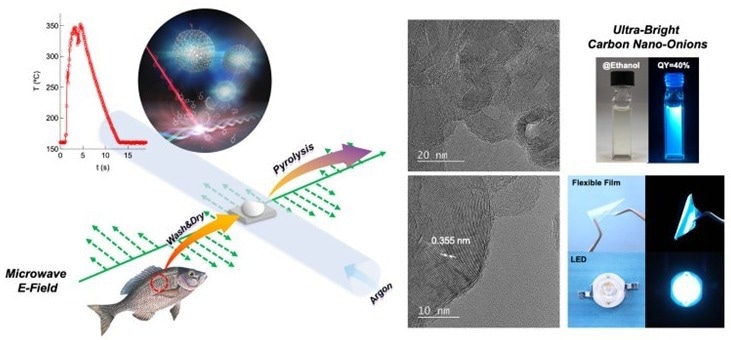Carbon-based nanomaterials are increasingly being used in electronics, energy conversion and storage, catalysis, and biomedicine due to their low toxicity, chemical stability, and exceptional electrical and optical capabilities.
 Converting fish scales into high-quality nanomaterials. (Left) Scheme depicting the synthesis of carbon nano-onions via the microwave pyrolysis of fish scales. The top inset shows the rise in temperature of the fish scales due to microwave absorption over a period of 10 seconds, as well as a proposed formation mechanism for the carbon nano-onions. (Right) transmission electron microscopy images showing the morphology of the synthesized carbon nano-onions and photographs of CNO dispersion in ethanol, an emissive flexible film, and an LED containing CNO. Image Credit: Takashi Shirai from NITech, Japan
Converting fish scales into high-quality nanomaterials. (Left) Scheme depicting the synthesis of carbon nano-onions via the microwave pyrolysis of fish scales. The top inset shows the rise in temperature of the fish scales due to microwave absorption over a period of 10 seconds, as well as a proposed formation mechanism for the carbon nano-onions. (Right) transmission electron microscopy images showing the morphology of the synthesized carbon nano-onions and photographs of CNO dispersion in ethanol, an emissive flexible film, and an LED containing CNO. Image Credit: Takashi Shirai from NITech, Japan
CNOs, or carbon nano-onions, are by no means an exception. CNOs, which resemble cages within cages, are nanostructures that were first reported in 1980 and are made up of fullerene concentric shells. They have several desirable characteristics, including a large surface area and strong electrical and thermal conductivities.
Unfortunately, there are also significant disadvantages to using traditional methods to make CNOs. Some involve a lot of time and energy, while others call for difficult synthesis circumstances such as high temperatures or vacuum.
Some methods can overcome these restrictions, but they need sophisticated catalysts, expensive carbon supplies, or hazardous acidic or basic environments. This severely restricts the potential of CNOs.
However, there is still some hope. A group of researchers from Nagoya Institute of Technology in Japan recently discovered a clear, concise, and practical method to convert fish waste into extremely high-quality CNOs, which was published in the journal Green Chemistry (available online on April 25th, 2022, and published in issue 10 on May 21st, 2022).
The group, which involved Associate Professor Takashi Shirai, Master’s student Kai Odachi, and Assistant Professor Yunzi Xin, created a method of synthesis in which fish scales, which are removed from fish waste after washing, are quickly transformed into CNOs by microwave pyrolysis.
But how is it possible to create CNOs from fish scales so quickly? The research believes that the collagen found in fish scales, which can absorb enough microwave radiation to cause a rapid spike in temperature, is to thank for the phenomenon, even if the exact cause is not 100% clear.
This results in heat degradation, also known as “pyrolysis,” which generates certain gases necessary for the assembly of CNOs. This method is noteworthy as it can convert fish scales into CNOs in under 10 seconds without the use of difficult catalysts, harsh environments, or extended waiting times.
Additionally, CNOs with very high crystallinity are produced by this synthesis technique. In methods that utilize biomass waste as a beginning source, this is incredibly challenging to accomplish. Moreover, during synthesis, (−COOH) and (−OH) groups are selectively and extensively added to the surface of the CNOs.
The surface of CNOs made using traditional procedures, which is normally bare and requires further processes to functionalize, contrasts sharply with this.
The applications of CNOs are significantly impacted by this “automatic” functionalization. Due to an attractive relationship known as pi-pi stacking, nanostructures have a tendency to stay together when the CNO surface is not functionalized.
As a result, it is challenging to disperse them in solvents, which is essential in any application requiring procedures based on solutions. Since the suggested synthesis method generates functionalized CNOs, it allows exceptional dispersibility in a range of solvents.
Unparalleled optical properties are yet another benefit linked to functionalization and high crystallinity.
The CNOs exhibit ultra-bright visible-light emission with an efficiency (or quantum yield) of 40%. This value, which has never been achieved before, is about 10 times higher than that of previously reported CNOs synthesized via conventional methods.
Takashi Shirai, Associate Professor, Department of Life Science and Applied Chemistry, Nagoya Institute of Technology
The researchers showed how their CNOs were used in LEDs and thin films that create blue light as examples of the numerous practical uses for their CNOs. Both inside solid devices and when dispersed in a wide range of solvents, such as water, ethanol, and isopropanol, the CNOs produced a very steady emission.
Shirai added, “The stable optical properties could enable us to fabricate large-area emissive flexible films and LED devices. These findings will open up new avenues for the development of next-generation displays and solid-state lighting.”
The suggested synthesis method also offers an easy solution to transform fish waste into exponentially more beneficial components while being ecologically benign. The team is certain that their efforts will help the UN achieve the majority of its Sustainable Development Goals.
Additionally, CNOs might significantly reduce the expense of manufacturing QLED screens and next-generation LED lighting.
There is an anticipation that these scientists’ efforts will help CNOs get more widespread acceptance in real-world applications.
【Research】Fabrication of Carbon Nano-Onions from Fish Scales by Microwave Pyrolysis
Fabrication of Carbon Nano-Onions from Fish Scales by Microwave Pyrolysis. Video Credit: NITech, Japan.
Journal Reference:
Xin, Y., et al. (2022) Fabrication of ultra-bright carbon nano-onions via a one-step microwave pyrolysis of fish scale waste in seconds. Green Chemistry. doi:10.1039/d1gc04785j.